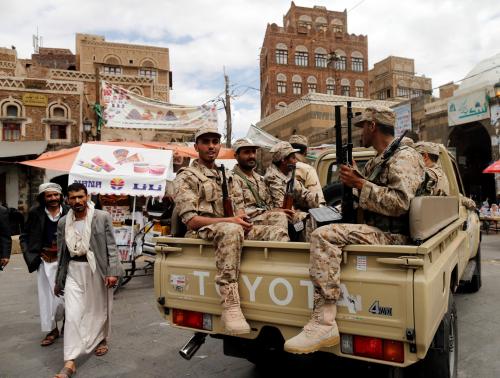Six years ago today, Saudi Arabia announced the beginning of Operation Decisive Storm from Washington, DC. Riyadh said the initial airstrikes were designed to push the rebel Houthis out of Yemen’s capital of Sanaa and restore interim President Abdu Rabbu Mansour Hadi to power. The war, which Saudi Arabia told Obama administration officials would take about “six weeks,” has not gone according to plan. Saudi Arabia has not achieved any of its military objectives in Yemen. President Hadi remains in exile, his government is weak and in disarray, and the Houthis are stronger now than they were when the fighting began.
Indeed, after six years of war, thousands of missiles and bombs, hundreds of thousands of deaths, and the world’s worst humanitarian crisis, Yemen has fractured to the point that it is unlikely ever to be reconstituted as a single state. Nor will the country revert to a pre-1990 north-south division. Instead of one or two Yemens, there are now multiple Yemens, tiny statelets and zones of control held by an expanding number of armed groups, all of which have different goals and trajectories.
The seven Yemens
In the northern highlands, where much of Yemen’s population lived prior to the war, the Houthis hold sway. In 2015, Saudi Arabia decided it had to intervene militarily to prevent the Houthis from becoming a Hezbollah-like group — backed and armed by Iran — on its southern border. But the war has only driven the Houthis and Iran closer together. Iran smuggles missile components to the Houthis, provides them with trainers, and supports them economically. In 2019, the Houthis named an ambassador to Iran, and the following year Iran reciprocated, installing Hassan Irloo, a member of the Islamic Revolutionary Guard Corps (IRGC), as its ambassador in Sanaa.
When Saudi Arabia intervened in 2015, the Houthis ruled the highlands in partnership with former Yemeni President Ali Abdullah Saleh. The two had been enemies: The Houthis and Saleh fought six wars against one another between 2004 and 2010. While they distrusted one another, they made common cause against Hadi and the Saudis. Over time, and thanks to a poorly conceived U.N. sanctions regime, which disproportionately weakened Saleh’s network, the Houthis were able to outmaneuver their domestic rival, eventually killing Saleh in December 2017. Since then, the Houthis have embarked upon an ambitious program of restructuring governance in areas under their control, which is designed to make removing the Houthis and re-unifying Yemen impossible.
Along the Red Sea coast, Saleh’s nephew, Tariq Saleh, heads a group of fighters, backed by Saudi Arabia and the United Arab Emirates (UAE), who are positioned against the Houthi frontlines in Hudaydah.
Further inland in Taiz, the conflict is largely between members of the anti-Houthi alliance. The Houthis hold the northern part of the governorate, but Islah, a political party with ties to the Muslim Brotherhood, has won the battle within the anti-Houthi alliance, defeating rival fighters from the 35th Armored Brigade and the Abu al-Abbas group for control of the city of Taiz and much of the countryside south of the city.
The secessionist-minded Southern Transitional Council (STC) holds the southern port city of Aden after pushing Hadi’s forces out in August 2019. The STC and its affiliated military units are backed by the UAE, which opposes Islah based on its ties to the Muslim Brotherhood.
North of Aden, another UAE-backed group, the Salafi-led Giants Brigades, is active in Lahj. Many of these fighters favor secession as well, just not STC-led secession.
In Marib, the site of the current Houthi offensive, Islah is in charge. Hadramawt is split between the UAE-backed Hadrami Elite Forces, who control the coast, and Islah-affiliated units in the interior.
In al-Mahra, on Yemen’s eastern border, Saudi Arabia and Oman are playing a not-so-secret game for influence with local tribes. Saudi Arabia has built up its military presence on the Omani border, establishing at least two dozen bases over the past three years and recruiting locals for paramilitary groups. Oman, which sees al-Mahra as within its sphere of influence, has grown increasingly concerned with the Saudi military presence on its border and is working to undermine it. The STC has control of the island of Socotra, and Hadi’s units hold Yemen’s “triangle of power,” the oil and gas fields of Marib, Shabwa, and Hadramawt.
Yemen will not be put back together again
None of these various armed groups — whether Hadi’s forces, the Houthis, or the STC — are strong enough to impose their will on the rest of the country. Yet nearly all of these groups possess enough men and munitions to act as a spoiler to any national peace deal they feel does not adequately address their interests. More concerning still is the fact that the longer the fighting continues, the more armed groups are likely to emerge. The STC didn’t exist in 2015; today it holds Hadi’s temporary capital of Aden.
Combine that with the fact that Yemen has a shrinking economic pie — exports are largely limited to the oil and gas fields in Marib, Shabwa, and Hadramawt — and the recipe is in place for years of conflict to come. In the future, more and more groups will be fighting over fewer and fewer resources. This is already on display in Marib. The Houthis know that in order to survive as an independent state in the highlands they will need export revenue. This calculation is a major reason for the Houthis’ latest offensive, which is aimed at both the city of Marib as well as the surrounding oil fields.
None of the various peace efforts — whether the U.N. or U.S. special envoys, or Saudi Arabia’s latest offer of a ceasefire — seem to understand this. The Houthis do not want to be part of a state; they want to be the state. They are not about to give up at the bargaining table what they believe they have won on the battlefield.
Even if the Houthis and the STC were willing to negotiate to be part of a restructured Yemeni state, there is no guarantee that, at this late date, the state could actually be put back together. Thanks to a shortsighted decision by Hadi to split Yemen’s Central Bank in 2016, the country has two separate economies. The Yemeni Riyal trades at one rate in Houthi-controlled Sanaa and another in STC-controlled Aden. Newly printed riyal bills, which were issued by Hadi’s government, are banned in Houthi areas.
Yemen’s fragmentation raises a number of challenges for the United States. The U.S. isn’t going to recognize all of the different warlords and armed groups that hold sway on the ground in Yemen. But for a variety of reasons, from counterterrorism to humanitarian and refugee concerns to Red Sea shipping lanes, the U.S. is going to have to deal with many of them.
The nation-state system is the key building block of diplomacy, international relations, and national security. The United States, like most countries, is set up to deal with other nation-states. The military prefers to work “by, with, and through” local partners. But what happens when there is no partner on the other side, when the gulf between what Yemen’s internationally recognized government claims and what it actually controls becomes so great the fiction of a single state finally collapses?
The answer isn’t clear, but increasingly in countries like Yemen, Syria, and maybe even Libya, it is a question the U.S. is going to have to solve.
The Brookings Institution is committed to quality, independence, and impact.
We are supported by a diverse array of funders. In line with our values and policies, each Brookings publication represents the sole views of its author(s).











Commentary
The end of Yemen
March 25, 2021